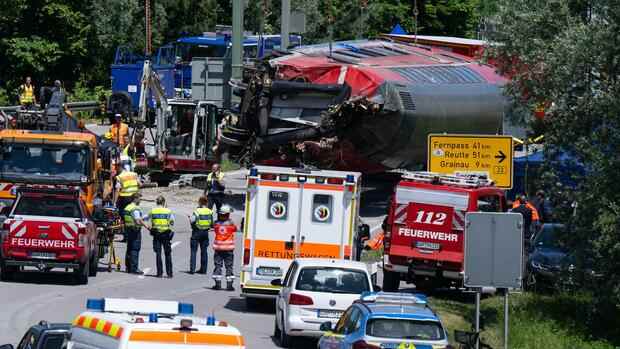Frankfurt The experts at the Federal Bureau of Railway Accident Investigation (BEU) are working flat out on one of their most tragic cases in recent years. You have to clarify why the regional train RB 59458 derailed shortly after leaving Garmisch-Partenkirchen last Friday and killed five people. More than 40 people were injured, and all missing persons cases were resolved by Sunday afternoon. In the meantime, the BEU has confiscated the train. A special commission called “Zug” headed by the Munich Public Prosecutor’s Office II is also supposed to help clarify the accident.
The public is waiting for an explanation, but it may be some time before the experts present their report. The findings written there must be secured. Because it’s not just about finding possible culprits. As is usual in aviation, the BEU may derive new specifications from the results in order to prevent similar accidents in the future and to further increase safety on the rails.
The pictures of the scene of the accident and the first evaluations of available data already point in the direction of a technical defect on the train or on the route when investigating the cause. According to the responsible authorities, the investigations are also concentrating on these two possibilities for the time being.
There are several reasons for this: the so-called control car at the head of the train – it has no drive – was still largely on the rails after the accident, as was the locomotive that was pushing from behind. Three of the cars in the middle of the train derailed. If the engine driver had driven too fast, the front control car would probably have jumped off the tracks as well.
Top jobs of the day
Find the best jobs now and
be notified by email.
According to initial information, the BEU also found no evidence of excessive speed in the train’s so-called data recording device – roughly comparable to a flight recorder. There are no switches at the scene of the accident, and no other train was involved. In this respect, human error, for example on the part of the engine driver – he has now been questioned for the first time – or by the staff in the signal boxes can be largely ruled out.
Did something block the train?
A technical defect is currently the most likely cause of the accident. There are several possible scenarios for this. The fact that the middle wagons jumped off the tracks indicates the following sequence of events: the train could have been blocked by something at the front, which the control car could not counteract without its own power. The locomotive pushed on from behind, the wagons somehow had to give in to this pressure and derailed.
The number of fatalities after a train accident in Garmisch rises to five
As recently as Friday, there was speculation that an object on the rails could have triggered such a blockage. In the past, objects placed on the tracks had caused trains to derail. So far, however, no evidence of an object on the rails has been found at the scene of the accident.
Another possible scenario: Damage to the track causes the bogie of a wagon to jump off the tracks, and the train driver immediately triggers an emergency brake. But it takes a long time for the vehicle, which weighs many tons, to come to a standstill. Because the derailed bogie is blocked, the three wagons jump off the rails.
A defect on the train, for example a damaged wheel, could also have led to the accident. 24 years ago, a broken wheel rim derailed an ICE train at full speed at 200 kilometers per hour near Eschede in Lower Saxony. 101 people lost their lives, it was the worst railway accident in the history of the Federal Republic of Germany.
At that time, wheels with rubber damping were installed in the ICEs to increase driving comfort. The accident investigators identified these as weak points, and all wheels on the high-speed trains were then replaced. In the meantime, Deutsche Bahn also generally uses wagons with solid wheels for regional trains.
Investigators from the Federal Office for Railway Accident Investigation and the public prosecutor are looking for the cause of the accident.
(Photo: Getty Images)
After the accident, the question quickly arose, especially on social media, as to whether the German railway network was still safe. But the accident in Bavaria does not mean that the condition of the rail network also affects the safety of train traffic.
It is well known that the rail infrastructure in Germany is in dire need of renovation. Faults in points or signals have been causing long delays or train cancellations for months. In addition, more is being built than ever before. This has plunged the state-owned company Deutsche Bahn into a deep crisis.
But numerous safety systems are installed on the tracks. Anyone who has ever experienced a disruption on the route or on the train knows how long it takes before things can continue. The experts from the Federal Railway Authority (EBA), a supervisory authority that reports to the Ministry of Transport, take a close look at everything beforehand. The accident investigators now active in Bavaria are also affiliated with the EBA.
According to calculations by the Federal Statistical Office, between 160 and 180 people die in rail accidents in Germany every year. For comparison: around 2,600 people die every year on the road. In addition, most people die on tracks, for example at level crossings or in similar accidents, not because of trains that have derailed or collided.
This makes rail travel relatively safe – despite the dilapidated rail infrastructure.
More: Municipalities are demanding permanently cheap tickets for buses and trains
